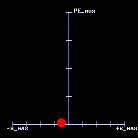Simulation/Animation
 Simulations and Animations
Simulations and Animations
This page has become a sort of "rogues' gallery" for multimedia and other technical capabilities with which we are experimenting. Most of the examples found here are integrated into the Course Notes for this design case study.
-
 Diatomic hydrogen:
Diatomic hydrogen:
- This animation illustrates the harmonic stretching motion typical of the covalent bonds in molecules. In this simplest of examples, thermal energy (at 300 K) imparts velocity to the two atoms of diatomic hydrogen. If the atoms move apart, the restoring force of the bonding orbital brings them back together; if they move too close, the same restoring forces push them back apart. In this example, translation and rotation of the molecule have been subtracted.
This example illustrates animation capabilites. The animation is an SGI .movie format replayed using Movieplayer. The action is from a previously-generated Molecular Dynamics simulation. Ball-and-stick rendering and lighting effects are created using the Biosym InsightII GUI interface.
-
 Water:
Water:
- This animation illustrates the coupled motions of bond stretching and bond angle bending in a water molecule: H2O. The sp2 hybrid molecular orbital geometry creates a preferred angle of about 109 degrees for the H-O-H angle. On top of the opening and closing of this angle, you can observe symmetric and asymmetric stretching of the two H-O bonds.
This example illustrates animation capabilites. The animation is an SGI .movie format replayed using Movieplayer. The action is from a previously-generated Molecular Dynamics simulation. Ball-and-stick rendering and lighting effects are created using the Biosym InsightII GUI interface.
-
 Ethane:
Ethane:
- This animation illustrates the rotational (torsional) freedom of molecules about single bonds. In ethane, each carbon exhibits sp3 hybrid molecular orbital geometry. Within each terminal CH3 group you can observe both angle bending and bond stretching, as well as stretching of the central C-C bond. Repulsion between the hydrogens on either CH3 group provides a small barrier to rotation about the C-C bond, but at 300 K there is enough thermal energy to overcome the barrier and rotation occurs.
This example illustrates animation capabilites. The animation is an SGI .movie format replayed using Movieplayer. The action is from a previously-generated Molecular Dynamics simulation. Ball-and-stick rendering and lighting effects are created using the Biosym InsightII GUI interface.
-
 Harmonic Oscillator:
Harmonic Oscillator:
- This link fires up a simulation for the motion of a simple one dimensional harmonic oscillator. The motion of the oscillator is recreated using Molecular Dynamics with a simple Verlet time step of constant length. A more detailed description is available. The results are displayed graphically. The mass and force constant of the harmonic oscillator are fixed. You can vary the size of the time step or explore different representations of the dynamic behavior.
This example illustrates a link to simulation. The simulation itself is customized to accept html FORM input and opens its own window on the display specified by the user. (This display is generated using SGI's GL graphics library and may not be compatible with all computer systems.)
-
 Molecular Geometry:
Molecular Geometry:
- This is a project under development to explore the capabilities of the Web as an interactive user interface.
This example illustrates the use of bit-mapped images to provide input to customized scripts which then return information to the user from accessible file data.
-
 Molecular Mechanics simulation
Molecular Mechanics simulation
- This is a project under development to link an interactive Web browser interface to commercial software.
This example illustrates the capability to run a molecular simulation on a remote server and to display the results locally in a user-friendly format using Java code. Proprietary commerical software is used to run the simulation, which is structured so as to permit the student to explore the numerical aspects of the energy minimzation technique, using a few sample molecules as working guides.
MIT Home page | UP one level | Ask the Professor
Last modified 6/20/97 - GCR Simulations and Animations
Simulations and Animations Simulations and Animations
Simulations and Animations Diatomic hydrogen:
Diatomic hydrogen:
 Water:
Water:
 Ethane:
Ethane:
 Harmonic Oscillator:
Harmonic Oscillator:
 Molecular Geometry:
Molecular Geometry:
 Molecular Mechanics simulation
Molecular Mechanics simulation